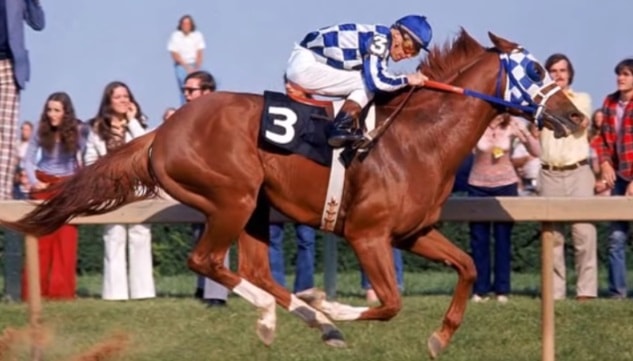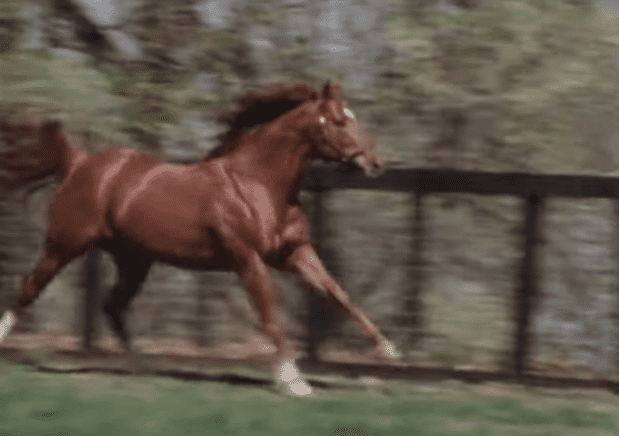The world of horse racing has always had an impressive history and a particularly intricate fascination with high fashion hats. But what makes this industry so remarkable is the young thoroughbred athletes that join the winner’s circle every year. There is no doubt that each horse has a unique ability to run a mile and a quarter with an unmissable speed, but now and then comes along a horse that sweeps the crowd off their feet, leaving behind a path of legendary successes. Such a horse was known as the great Secretariat of the 1970s, who became the first racehorse to win the Triple Crown title in over 25 years. Famously nicknamed “Big Red,” this horse redefined the meaning of a legend, setting race records and track paces that no one saw coming from a mile away. Even after his death in 1989, Big Red had already paved a new road for the world of horse racing, dripping a little bit of his legendary heart down along his long family tree.

A Legend Is Born
In the fall of 1970 at 12:10 am, a sorrel-bodied, white-socked, and chunky young thoroughbred was born to a quiet Virginia stable, recently under the new management of the ambitious Penny Chenery. Meadow Farm, Secretariat’s new home, has recently suffered the loss of its owner and Penny’s father, Chris Chenery, to cancer. This tragedy left the family at a loss both emotionally and financially, leaving Chris’s children to decide the faith of the farm. Dedicated to her father’s legacy, Penny, a wife and mother, dismissed the cautionary worries of her siblings and positioned herself as the farm’s new face.
Penny Chenery Makes a Bold Move
In 1969, Penny decided to breed the stable’s mare, Somethingroyal, to the stud, Bold Ruler, to bring profitability back to the farm’s name. Not only did Penny bring life back to the farm, but she introduced a legend into the world that day. Right away, the farm’s hired stud manager, Howard Gentry, gave notice of the foal’s big-boned structure, chalking him up as too “chunky.” Even Secretariat’s life-long friend and groom, Eddie Sweat, was unimpressed by the foal’s build, leaving Penny weary of the farm’s future.
A Top Trainer For A Top Horse
As Big Red grew, so did his legs, and by his second birthday, he has finally started putting them to good use. Hall of Fame Thoroughbred horse trainer Lucien Laurin was tasked to make the strong-boned, lengthy sorrel understand how to use his newfound legs. Standing at 16.2 hands with 1,175 pounds, Laurin has a lot of work ahead of him.
In Secretariat’s First Year Racing He Was Named Horse of the Year!
After his endless training sessions and practice times, Laurin decided to enter Big Red into his first race at the Aqueduct Racetrack in New York City. Reeling from a rough start out of the gate, being bumped by his competitors, Secretariat was able to make considerable headway by the final stretch of the race. From 10th to fourth in a matter of minutes, the 2-year-old made losing look like a winning game.
After this impressive start to his quickly moving career, Secretariat was entered in nine more races that season, winning seven of them by considerable lengths. By the end of his first season, he has become a crowd favorite and was quickly named the Horse of the Year. The newfound crowd-pleaser had developed a signature move leaving at least six lengths between him and the runner up every race.
The Secretariat Syndicate
In 1973, despite Big Red’s seemingly unbeatable winning streak, Meadow Farm, specifically Penny, was hit with an alarming tax bill. To combat the ever-growing financial troubles of the farm, this ambitious mother was able to syndicate Big Red, selling 32 shares for a record-breaking $6.08 million. Every cent proved their worth during his debut race that same year.

In 1973 Secretariat Gallops To Greatness
In 1973, Secretariat was entered in the Kentucky Derby, where his signature moved proved to be evolving. Despite a rocky start at the gate, Big Red, left his competitors in the dust, set a racetrack record of 1:59 2/5th, a record that has only ever been touched by one other horse in decades. After this groundbreaking victory, Big Red was on a roll, coming from behind and winning the Preakness two weeks later, setting yet another racetrack record of under 2 minutes. Due to this new trophy to add to the pile, Big Red had become an internationally recognized star, making the cover of various high-end magazines included Time and Sports Illustrated.
Secretariat Makes History Winning The Triple Crown
Coming full circle, in June of ‘73, Big Red was to face the final race of notable Triple Crown at Belmont Park, where the crowd became muzzled with anticipation. Ready to take on the crowd’s high expectations, Secretariat flew out of the gate with a passion, taking the lead position from the get-go. As the race track grew shorter and shorter, Secretariat found himself in a battle for the gold with his rival, Sham, who gave him a run for his money, literally.
Halfway through, despite Sham’s undying effort, Secretariat did what he does best; run without looking back. It was as if the sorrel had waited his entire life for this moment to show the world what greatness he had in store. By the finish line, there was a total of 31 lengths between him and Sham, a feat no jockey, trainer, or even racetrack had ever seen. Already put on the map by his show stopping athleticism, Secretariat boldly became the first winner of the Triple Crown since the year 1948.
Check Out The Race Below In A YouTube Video, Showing Secretariat Winning by 31 Lengths.
Secretariat A Famous Race Horse
Magazines, newspapers, and museums simply could not get enough of this magnificent creature. From cover photo shoots to special inductions into world-class museums, Big Red had truly captured the spotlight. As if saving the best for last, Big Red’s race times from all three Triple Crown events remained unmatched for decades after his impressive work. While he raced once more after the remarkable feat at Belmont Stakes, Big Red retired to a life full of praise and rewards. Among his tributes stands a statue of the Big Red himself, rearing with power outside the Belmont Park to this day.
Retired Big Red Proved He Had A Big Heart.
Soon after his retirement, Big Red would become the most anticipated stud within the racing industry. Assured that racing days would end after his third year, his breeding rights sold for an impressive six million dollars. Of the 582 foals by Secretariat, 41 soon became high stakes winners, following their great father’s footsteps. While his offspring have shown impressive feat of athleticism on the racetrack, it is rumored that there will never be another legend such as Big Red.
Check Out The This Tribute to Secretariat by TheChampionsOfRacing YouTube Channel below;
In October of 1989, at the age of 19, Secretariat had come to the end of his incredible life. But even after his peaceful passing, this magnificent horse was able to amaze us yet again. During the autopsy, veterinarian Dr. Thomas Swerczek found that his heart was among the largest ever reported in a horse, nearly twice the standard size. From the thick-boned and chunky foal that everyone doubted to the first Triple Crown winner in over 25 years, it all came down to a big, and unconditionally loving heart.
